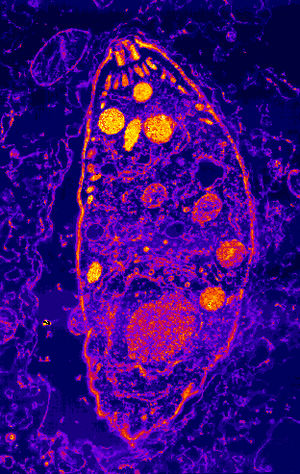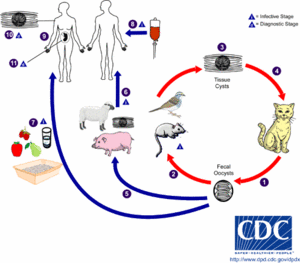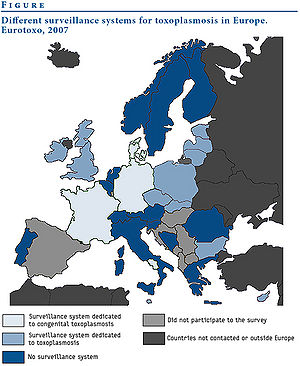Toxoplasmosis and Global Health
Introduction
By Lizzie Leonard, BIOL 191 GLOBAL HEALTH
Toxoplasmosis is a disease caused by the protozoan parasite Toxoplasma gondii. The primary host is the Felidae family-- a genus composed of wild and domesticated cats. However, it infects most warm-blooded animals, including humans. Up to one third of the world's human population is estimated to be carrying a Toxoplasma infection (Source 8), and the life cycle of this parasite plays a huge role in its easy transmission.
There are two parts to the life cycle of Toxoplasma Gondii. See Figure 2 for a visual representation of the life cycle. The first component is the sexual part of the life cycle, or the Infective Stage. This can only take place in the Felidae family. The microbe is consumed by these felines and then survives passage through the stomach. After passing through the stomach, the microbe infects epithelial cells in the small intestine. The microbes undergo sexual reproduction and form oocycsts, the fertilized cyst of a microbe. This oocyst is shed with the feline's feces, where Intermediate hosts in nature such as birds and rodents ingest these contaminated oocysts. In the intermediate host's body, the parasite transforms into a tachyzoite shortly after transmission. A tachyzoite is a mobile, spore-forming parasite that forms tissue cysts. A cat becomes infected with this microbe when it ingests an intermediate host that is harboring these tissue cysts. The disease is spread again when a cat defecates, and other species are exposed.
The asexual part of Toxoplasma Gondii's life cycle begins when another mammal, usually a human, ingests these contaminated feces by various methods. The parasite enters cells in the intestine, is transferred to the blood stream, and is then distributed throughout the body. These microbes can have detrimental, even fatal, affects on certain individuals, and the hardiness of the cyst means that it can withstand many environments and infect various individuals. Given certain humidity and temperatures, the parasite can live in soil for up to a year. Additionally, infected cats often appear healthy, meaning that this disease is hard to identify and resistant enough to endure many disinfectants and other eradication methods. (Source 2)
Disease Transmission
Toxoplasmosis is mostly spread through defecation by the Felidae species. Transmission to humans, as well as other mammals, may occur by the following methods:
-Eating undercooked, raw, or partially cooked meat is a very effective way of spreading this disease. Any pork, lamb, or venison can contain Toxoplasma cysts, and when these meats are not fully cooked, and then consumed by humans, the parasite can infect the human as well. This becomes a major issue in developing countries where undercooked meat is commonly eaten.
-Hand-to-mouth contact after handling this undercooked meat is also a threat to human transmission. In cultures where meat handling is not always a hygienic process, the Toxoplasma parasite can be spread by dirty knives, utensils, or cutting boards that have been contaminated.
-The ingestion of cat feces plays a huge role in every life cycle of Toxoplasmosis. The fecal oocysts are spread in cat excrement, which leads to the infection of an intermediate host. Cat feces also carry the disease in the Diagnostic stage of the life cycle, as humans can inadvertently consume feces through various everyday activities. Gardening or spending time in fecal-contaminated soil, carrying the parasite after changing the litter box of an infected feline, or consumption and exposure to intermediate hosts that, too, carry the parasite from infected feces can all permit transmission of Toxoplasma.
-Water sources can also be contaminated with Toxoplasma, when cats or infected intermediate sources defecate in public watershed areas and runoff collects the parasite. Humans who drink this diseased water can ingest the parasite and it will consequentially be spread throughout their body and infect their own cells.
-An extremely rare method of transmission but one that occurs nonetheless is by receiving an infected organ transplant or blood infusion. Since the parasite is spread throughout the blood stream, an infected individual can spread it to another human during transplants and infusions.
-Congenital Toxoplasmosis is a form of the disease during which an unborn child is infected through the placenta inside of its mother. If a pregnant woman has never been exposed to Taxoplasmosis before, her baby is put at risk. Therefore, pregnant women should avoid handling raw meat, being exposed to cat feces, and other household chores that involve exposure, such as changing a cat's litter box and gardening, since cat feces are common in garden soil.
The transmission and prevalence of this disease seems to be distributed differently around the world. In France, there is a high prevalence of infection, probably due to the cultural preference of eating raw or undercooked meat. In developing countries in Central America, the high prevalence of disease there can be traced back to the frequency of stray cats in that location. Between 1988 and 1994, the National Health and Nutrition Examination Survey (Source 1) collected information on the prevalence of Toxoplasmosis in the United States. It was discovered that 22.5% of adolescents and adults had the parasite in their bloodstream, with a prevalence with women of childbearing age of 15%. The prevalence of this disease is not as high in a developed country as the United States because hygienic practices and control of wild feline species can all contribute to the prevention of high rates of transmission.
Transmission of Toxoplasmosis can also be attributed to the type of lifestyle that individuals live in. A study was conducted between August 2007 and October 2008 in Qualyobia Governorate, Egypt to measure the prevalence of Toxoplasmosis in pregnant women. The results indicated that Toxoplasma Gondii was more prevalent in rural areas- 57.6% were found to be suffering from this disease- versus the urban areas, where only 46.5% were found to be infected. (Source 7) The society that citizens live in definitely plays a role in whether or not they will be affected by Toxoplasmosis. These rural areas of Egypt generally have higher levels of stray cats, because the open environment provides them with places to live and breed. Additionally, healthcare is more sparse in these areas, making it harder for infected individuals to get the attention and treatment that they may need.
Surveillance systems may be helpful in identifying and treating Toxoplasmosis early on in infection. A study was conducted in European countries from 2004 to 2007 to see which of the countries had a system implemented for identifying Toxoplasmosis. A questionnaire was sent to 35 countries in the European geographical area that were known to have the epidemiological surveillance systems in their countries. Data was collected for the three years, and 28 countries responded to the survey. 16 countries reported routing surveillance for Toxoplasmosis, whereas in 12 countries, surveillance was only conducted on citizens who showed symptoms of the disease. The 16 countries that reported conducting routine checkups for Toxoplasmosis were located in Central or Eastern Europe. Additionally, only four countries reported conducting checkups for congenital Toxoplasmosis. Figure 3 shows a geographic layout of these countries. However, this study concluded that more surveillance needs to occur, because it could definitely help cut back on infected individuals and lower the threat of disease.
Disease Impact
According to the Center for Disease Control, Toxoplasmosis is the third leading cause of death in the United States that can be attributed to foodborne illnesses. A recent study showed that more than 60 million men, women, and children in the United States carry the Toxoplasma parasite, but few of these victims show symptoms because the immune system can prevent the parasite from causing illness. (Source 3).
Toxoplasmosis is unique in the fact that it does not usually have severe impacts on the infected host. As one of the world's most common parasites, the human body immune system can usually prevent the parasite from harming the host. Generally healthy people have the ability to keep this parasite in an inactive state for its entire life. This also creates immunity to the disease, because the human immune system learns how to keep the parasite at bay, and the infected human cannot become diseased again with Toxoplasmosis. However, some people who suffer from Toxoplasmosis can suffer from minor disabilities like swollen lymph nodes, headaches, body aches, fever, fatigue, and even a sore throat (Source 4).
The complications arise when an immunocompromised individual contracts Toxoplasmosis. People who are undergoing chemotherapy, are taking immune-system weakening prescriptions, are living with HIV/AIDS, or are pregnant are all at risk for serious health problems once they are diagnosed with Toxoplasmosis. Chemotherapy weakens the human's immune system, making it more strenuous for the body to fight minor infections such as Toxoplasmosis. Similarly, HIV/AIDS severely weakens the human immune system, and the infected individual will have a very difficult time resisting the parasite. Even individuals who take medicines or prescriptions that treat nonmalignant conditions but weaken their immunity can all suffer from more extreme cases of Toxoplasmosis. Those who undergo the more serious form of this disease could experience symptoms such as headaches, confusion, poor coordination, seizures, lung problems, and even blurred vision. (Source 4)
The contraction of Toxoplasmosis during pregnancy also poses a large risk to a mother as well as her child. However, if a woman has acquired Toxoplasmosis prior to her pregnancy, the fetus is not usually at risk. According to the Organization of Teratology Information Services, in about 40 percent of the cases in which a pregnant woman has Toxoplasmosis, her fetus is also infected. (Source 2). One study done by the March of Dimes discovered that about one in ten infected babies has a severe Toxoplasmosis infection evident at birth. These newborns suffer from devastating symptoms such as eye infections, an enlarged liver and spleen, jaundice, and pneumonia. Many children die within a few days of birth, and those who survive may be mentally retarded, have impaired eyesight, cerebral palsy, seizures, and other debilitating effects. Unfortunately, Toxoplasmosis during pregnancy can also lead to devastating problems during childbirth, such as a miscarriage or stillbirth. (Source 2). Overall, pregnant women should avoid all possible methods of Toxoplasmosis contraction, because the result can be devastating.
Currently under debate in the scientific world is the possible connection between Toxoplasmosis and Schizophrenia. It is believed that Toxoplasmosis may be a leading cause of Schizophrenia, because the two can lead to similar psychotic symptoms. Additionally, some medications that have been used to treat Schizophrenia, such as Haloperidol, also stop the growth of Toxoplasma Gondii, the Toxoplasmosis parasite, in cell cultures. Finally, studies have found higher levels of Toxoplasma antibodies in Schizophrenia patients compared to the general population. (Source 5). Parallels have been drawn between the two diseases because the Toxoplasma parasite forms cysts inside human brain cells, producing an enzyme called tyrosine hydroxylase, which is needed to produce dopamine. Schizophrenia itself is characterized by an increase in dopamine levels, and Toxoplasmosis could be aiding Schizophrenia-infected cells in their infection of the host. (Source 6). Therefore, research studies are being conducted to try to find a link between these two diseases, which is difficult to do because many factors impact the contraction of both Toxoplasmosis as well as Schizophrenia.
Treatment and Diagnosis
As mentioned earlier, treatment for Toxoplasmosis is usually unnecessary in patients who are healthy and have a fully functioning immune system. Their immune systems are usually able to fight off the Toxoplasma parasite and prevent it from becoming virulent and threatening the patient. For those immunocompetent patients who still wish to combat the parasite, they can still be treated with drugs such as pyrimethamine and sulfadiazine. Both pyrimethamine and sulfadiazine have similar roles in treatment- the former inhibits dihydrofolate reductase, and the latter stops the production of folic acid. Dihydrofolate reductase and folic acid are both needed in order to synthesize the parasite's DNA, which leads to production of infectious proteins.
For immunocompromised individuals, treatment is more pertinent and necessary. The recommended treatment is a combination of pyrimethamine and trisulfapyrimidines administered for a month. The combination of these two medications also inhibits dihydrofolate reductase in the T.gondii parasite.
For pregnant women suffering from Toxoplasmosis, there are different treatments based on whether the fetus has acquired the disease or not. If the fetus is not yet infected, then spiramycin is administered to the mother, which is an antibiotic that localizes to the placenta and can reduce infection by 60%. However, this drug may have some negative effects on the fetal development, so the risks must be weighed before administration. If the fetus has already been infected, then the mother is treated with the aforementioned drug combination reserved for immunocompromised patients- pyrimethamine and trisulfapyrimidines.
Conclusion
Overall, Toxoplasmosis can have extremely detrimental effects on anyone who contracts the disease. Although most immunocompetent patients are able to combat the parasite, many individuals who are either suffering from a disease that renders them immunocompromised, pregnant women, or individuals whose medication weakens their immunity might find that Toxoplasmosis has more of a negative impact on their bodies than expected.
Thus, it is very important to practice prevention of the disease, so that treatment does not need to be employed. Some measures that should be taken by all individuals are the following: wearing gloves or washing hands after and during gardening or yard work, not consuming undercooked or raw meat, washing kitchen utensils thoroughly after use- especially cutting boards that have been used to cut vegetables from outside, washing and/or peeling fruits and vegetables before consumption, covering children's sandboxes and keeping outdoor play areas free from cat access, wearing gloves/washing hands after changing litter boxes, pregnant women should avoid touching litter boxes. having cats tested for toxoplasmosis, and keeping cats healthy to prevent disease contraction.
By inhibiting the spread of Toxoplasmosis, the levels of infected people can be lowered, and society can be an all-around healthier place. Taking these precautions is an imperative way to stunt the spread of this parasite, and every individual can play a role in this prevention.
References
Source 1- Center for Disease Control: Laboratory Identification of Parasites of Public Health Concern. November 21, 2009. <http://www.dpd.cdc.gov/dpdx/HTML/Toxoplasmosis.ht>
Source 2- National Toxicology Program- Department of Health and Human Services: Center for the Evaluation of Risks to Human Reproduction. November 21, 2009. <http://cerhr.niehs.nih.gov/common/toxoplasmosis.html>
Source 3- Center for Disease Control: Deparment of Health and Human Services. November 21, 2009. <http://www.cdc.gov/toxoplasmosis>
Source 4- Mayo Clinic-Mayo Foundation for Medical Education and Research. November 29, 2009. <http://www.mayoclinic.com/print/toxoplasmosis/DS00510/DSECTION=all&METHOD=print>
Source 5- http://en.wikipedia.org/wiki/Toxoplasmosis
Source 6- ScienceDaily Research Journal. November 30, 2009. <http://www.sciencedaily.com/releases/2009/03/090311085151.htm>
Source 7- U.S. National Library of Medicine National Institutes of Health- PubMed. El-Gozamy BR, Mohamed SA, Mansour HA. November 21, 2009. <http://www.ncbi.nlm.nih.gov/pubmed/19795746?itool=EntrezSystem2.PEntrez.Pubmed.Pubmed_ResultsPanel.Pubmed_RVDocSum&ordinalpos=6>
Source 8- ScienceDirect- The Lancet Scientific Newsletter. JG Montoya MD and ProfO Liesenfeld MD. November 30, 2009. <http://www.sciencedirect.com/science?_ob=ArticleURL&_udi=B6T1B-4CKMRPM-P&_user=7774802&_rdoc=1&_fmt=&_orig=search&_sort=d&_docanchor=&view=c&_acct=C000062877&_version=1&_urlVersion=0&_userid=7774802&md5=bff8536965ece8b926ff67bada377e58>
Additional Resources: MedlinePlus. December 4, 2009. http://www.nlm.nih.gov/medlineplus/toxoplasmosis.html
Stanford University School of Medicine. Cohen, Jonathan, Powderly, William G., John, David T. and Petri, William A. December 1, 2009. <http://www.stanford.edu/group/parasites/ParaSites2006/Toxoplasmosis/treatment.html>
Figure Legend:
Figure 1- an Electron micrograph of Toxoplasma Gondii, taken by scientists at the House Ear Institute.
Figure 2- Visual representation of the Infective and Diagnostic life cycles of Toxoplasma Gondii from the Center for Disease Control. http://www.dpd.cdc.gov/dpdx/html/Frames/S-Z/Toxoplasmosis/body_Toxoplasmosis_page1.htm
Figure 3- A map showing data from a Toxoplasmosis study conducted from 2004 to 2007. This study collected information on how much surveillance of Toxoplasmosis there was in each of these European countries. http://www.eurosurveillance.org/ViewArticle.aspx?ArticleId=18834
Edited by student of Joan Slonczewski for BIOL 191 Microbiology, 2009, Kenyon College.



